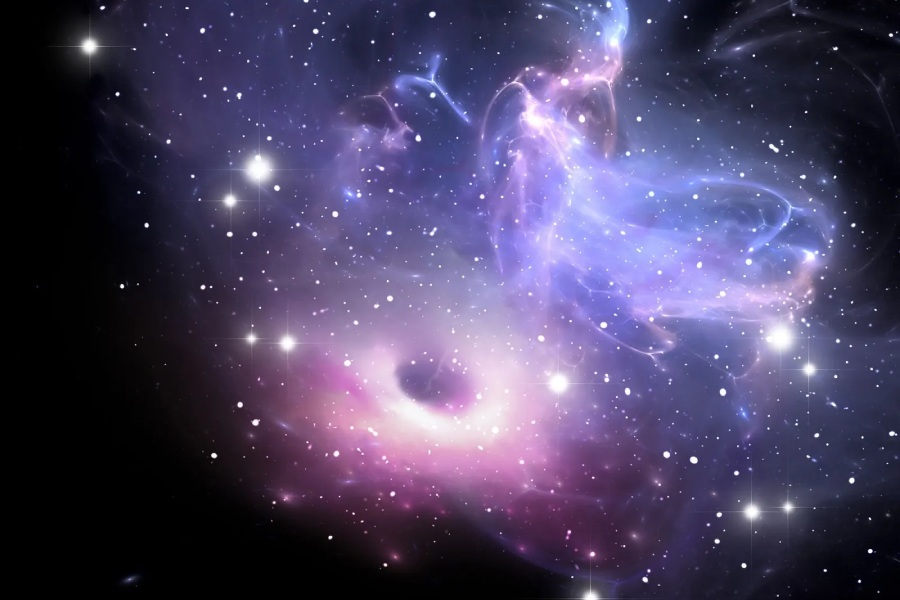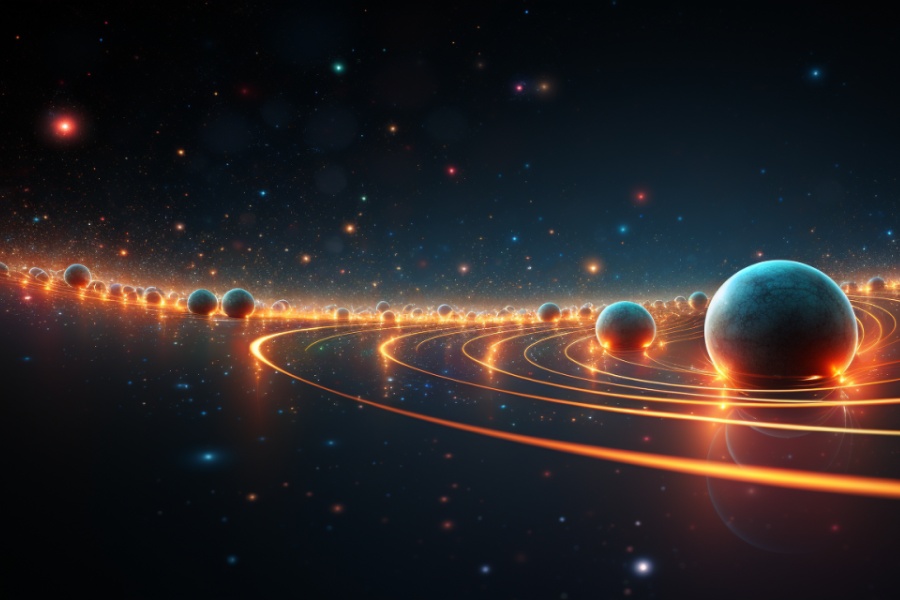Over 13 billion years ago, our universe began its long and eventful journey through galaxies’ emergence and conscious observers’ evolution across timescales. But when will the universe end? How long will the universe last?
We’ll explore potential outcomes, ranging from ongoing expansion across trillions of years to a complete cosmic collapse. It’s crucial to grasp the universe’s current trajectory to make sense of these projections.
Now, let’s dive in, begin our exploration, and see what happens when the universe ends!

When Will the Universe End?
The question of when the universe will end is complex, and scientists have different theories. One possibility is the “Big Freeze”, where the universe continues expanding until stars burn out and everything becomes cold and dark.
Another idea is the “Big Crunch”, where the universe contracts, leading to a massive collapse. Some theories also suggest a “Big Rip” , where the universe’s expansion accelerates so much that it tears apart.
So, how will the universe end? Currently, it’s uncertain which scenario will happen, and research is ongoing to understand the fate of our universe.
Open universe
An open universe has properties that lead to endless expansion and dilution into darkness over trillions of years. As space stretches, galaxies and cosmic structures move further apart until only remnants remain visible to observers not yet engulfed by black holes.
In an open universe, all usable energy becomes unusable energy. Complex matter decays as the cosmos trends towards disorder. The remaining particles decay into radiation, which becomes ever more dilute while approaching a state near absolute zero but never quite reaching it.
Endless expansion
Expansion occurs because the energy density in an open universe is less than the critical density needed to stop it. So, space-time stretches endlessly. Galaxies fade away as cosmic inflation outpaces their light.
Over time, stars stop forming as fuel sources dwindle across the increasingly empty cosmos. Without new stellar nurseries, the remaining stars fade as they use up their fuel. Among the remnants, black holes emerge as dominant compact objects, consuming surrounding material and possibly merging into a vast, dark abyss.
In this desolate universe, even particles may decay, leaving only scattered photons. These photons are the last traces of once vibrant galaxies and shining vistas before all energy fades into oblivion.
Closed universe
In a densely packed closed universe, expansion eventually slows down, and gravity takes over, leading to contraction or a “Big Crunch.” This process resembles a mirrored rewind, returning to the dense and fiery conditions of the Big Bang origin.
Potential contraction outcomes vary, ranging from a uniform global collapse to uneven crunches, giving rise to isolated cosmic zones supporting mini-universes with distinct realities. The paths taken depend on speculative particle physics guiding extreme transitions.
Contraction might affect the entire universe uniformly, reversing the outward trajectory of expansion. Alternatively, erratic quantum events near the end could create new inflationary bubbles, perceived as separate realms. However, limited observations from early epochs or futuristic states make it challenging to draw definitive conclusions.
Theorists engage in debates using conceptual extensions of current physics. The cosmic “end” definition becomes blurry, especially if conscious experience persists within budding sub-universes. As scientists push the boundaries of empirical understanding, space emerges for philosophical discussions regarding cosmology’s ultimate fate.
Contraction theories
The universe expands and then contracts uniformly, creating heat and density. During contraction, black holes merge, forming heavier elements from lighter ones. This leads to two possible outcomes: either a uniform collapse resembling the Big Bang or random crunches spawning daughter universes.
Without observations from distant futures, predicting details is challenging. Cosmologists rely on speculative physics, such as quantum gravity, to decode contraction processes mathematically.
However, separating theoretical equations from real-world viability remains a challenge. As a result, cosmic conclusions remain conceptual possibilities rather than confirmed projections.
Flat universe
In our vast universe, a delicate equilibrium prevails, guiding its steady expansion without favoring accelerated growth or inevitable contraction. The key lies in the total density of matter and energy, establishing an optimal rate for this ongoing expansion. This resilience is expected to endure for billions of years before a significant shift in balance occurs.
Examining our real universe aligns with this balanced, flat scenario based on density measurements and geometry. Yet, uncertainties surrounding the behavior of dark energy or gravitational theories could disrupt this equilibrium over trillions of years.
To safeguard against potential threats to prolonged flatness, meticulous observations strive to pinpoint the precise density. Even a slight deviation from perfect flatness can trigger a chain reaction, leading to endless expansion or an inevitable collapse.
Despite the current equilibrium, the subtle changes in physics over eons may eventually propel us away from this precarious middle ground, influencing the ultimate unfolding of the cosmos. The ongoing quest to understand the universe’s composition provides valuable insights into the transient nature of its stable flatness across deep time.
Balanced expansion
A flat universe finds perfect harmony by balancing expansion and gravitational forces, ensuring stable and resilient growth over time. Space smoothly glides outward without distortion across different epochs, thanks to the precise alignment of cosmic ingredients.
Yet, the delicate balance may face disruption from unknown physics over trillion-year timespans. Fluctuations in the strengths of opposing forces could tip the cosmic geometry towards either endless open expansion or destined closed contraction.
What seems like a perfect match of densities may only temporarily mask a gradual deviation buildup towards more radical cosmic shapes. Slight deviations in values could trigger runaway expansion or inevitable collapse over enough eons. Pinpointing the precision constraints of density foretells futures where flatness dramatically drifts.

Dark Energy and Accelerated Expansion
Dark energy is a mysterious form of energy causally linked to the accelerated expansion of space. Permeating the space homogeneously, it exerts a negative pressure counteracting gravity. The nature and permanence of dark energy hold the keys to determining the eventual fate of our universe.
Dark energy’s impact on the universe’s destiny
If dark energy keeps getting stronger over billions of years, as data suggests, it might stretch space quickly, leading to an open universe. But things could change soon, allowing for scenarios where the universe contracts. By understanding where dark energy comes from and how it changes, we can better grasp the big questions about how the cosmos might eventually meet its end.
What is dark energy?
Dark energy evenly fills space, having the same density throughout history after the Big Bang. It slowly causes an anti-gravity effect that pushes galaxies away from each other, the opposite of normal gravity over huge voids.
This weird energy with strong negative pressure makes up over 68% of all energy in the cosmos. But where it comes from remains a mystery, with competing ideas seeking to explain it. Whether dark energy fades or persists will determine the universe’s geometry and life cycle fates.
How does it affect the universe?
Dark energy, with its anti-gravity effect, continues to accelerate the expansion of the cosmos, causing galaxies to move farther and faster over time. Scientific models suggest that this force was less potent in the early universe but has strengthened as matter spreads thinly across space.
In the 1990s, researchers made a surprising discovery when studying the distancing of distant supernovae. The cosmic expansion was outpacing what gravity and matter alone could account for. This unexplained gap pointed towards the presence of unknown extra energy, giving rise to the concept of mysterious dark energy as the driving force.
The Heat Death of the Universe
In the heat death scenario, the universe keeps expanding until there’s no energy left to sustain processes due to maximal entropy. Temperatures get close to absolute zero. Eventually, stars burn out, and black holes vanish over incredibly long times as particles decay, leaving only photons behind.
As the universe expands, temperature and density differences that power mechanisms start evening out. Eventually, particles scatter too widely, leading to a state where useful potentials for work or structure formation are lacking.
Theoretical timeframe for heat death
The specific timelines hinge on concepts like dark energy and proton decay. Projections, however, suggest heat death occurring at least 10^100 years from now as the universe expands, pushing everything apart.
In this distant future, the observable universe appears desolate, with fading galaxies remaining as the last black holes emit their final particles. Without gas clouds resulting from expansion, the formation of stars and structured objects, such as planets, ceases. It’s possible that only a uniform dispersion of photons and particles persists, drifting through the vast expanse of cold, dark space.
Other Theoretical Endings
The Big Rip
The Big Rip theory suggests that dark energy, growing stronger over time, could overpower gravity and other forces. It would tear apart cosmic structures, from planets to atoms, and even spacetime as the expansion diverges. However, quantifying these speculative models proves to be a challenging task.
Models featuring a specific type of dark energy known as phantom energy lead to the Big Rip scenario. In this scenario, the repulsive effect of dark energy becomes infinite within a finite time as the expansion reaches infinity. This would result in a violent tearing of material on all scales.
Although mathematically valid, bringing the equations of the Big Rip into physical reality remains hypothetical. Confirmation regarding the nature of dark energy over cosmic time is necessary. Currently, our universe shows no indications of heading toward a Big Rip fate.
The Big Crunch
The Big Crunch theory envisions a universe that starts expanding but eventually contracts, ending in a hot, dense state similar to the Big Bang. Determining the likelihood of this scenario involves grappling with complex phase transitions and quantum gravity, which are uncertain.
In a hypothetical closed universe, the shift from expansion to centralized contraction occurs over immense timescales. As space-time condenses over eons toward a high-density singularity, this collapse models a symmetric cosmic cycle of death and rebirth. However, the challenge lies in understanding the intense physics bridging the earlier expansion and later contraction.
Quantum unpredictability adds to the complexity, making deductions difficult. Current measurements suggest a more likely scenario of indefinite expansion instead of a reversal towards contraction. Altogether, while the cyclic cosmology conceptually appears symmetric, it lacks explanatory and evidential support.
Conclusion
When will the universe end? The ultimate fate of the universe is uncertain, but current theories suggest possibilities such as heat death or a Big Freeze, billions to trillions of years in the future.
Reflecting on when and how the universe might one day end has taken us on an imaginative scientific journey. We explored cosmic possibilities from asymptotic fading heat death to reality-shattering Big Rips.
Contemplating the potential end of our universe may be disconcerting, yet grasping the physics behind it helps us appreciate the flourishing of life now. Understanding the balance and stability of maintaining our current universe state enlightens us.
This fosters a deep appreciation for the fleeting miracle of our emerging universe. While its expiration remains uncertain, we hope theories about its end shed light on the privilege of witnessing our cosmos’s delicate balance and brilliance.
